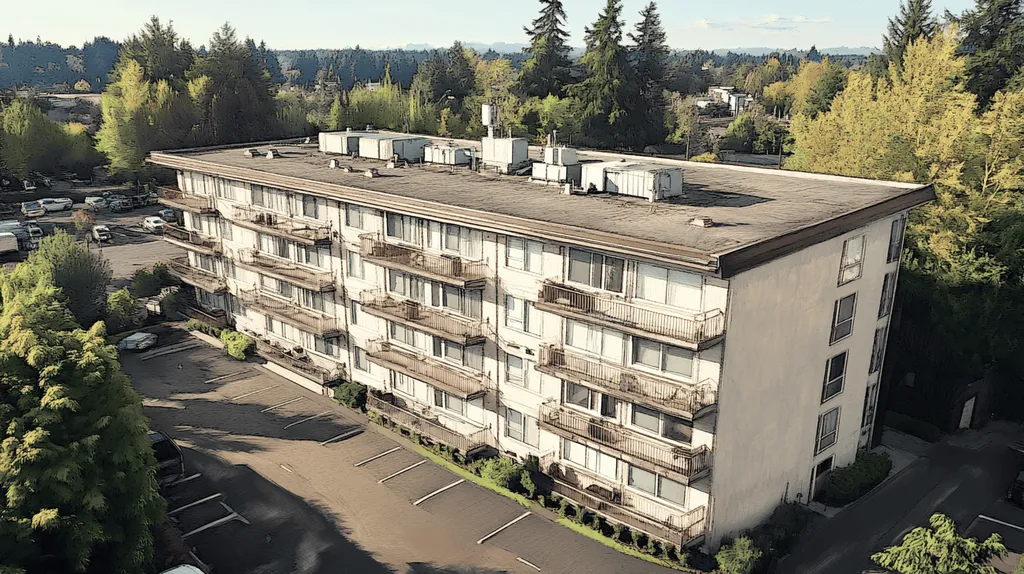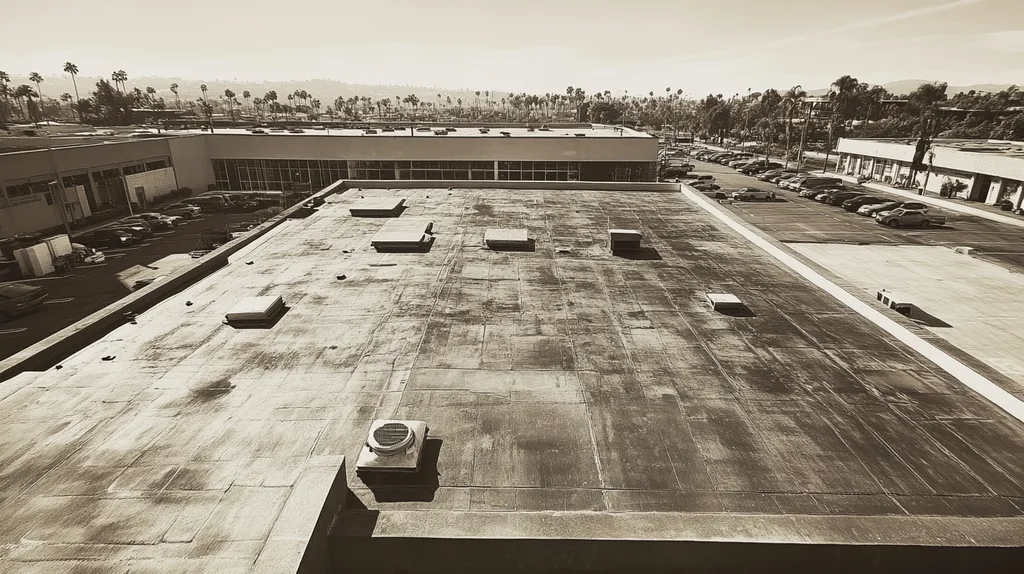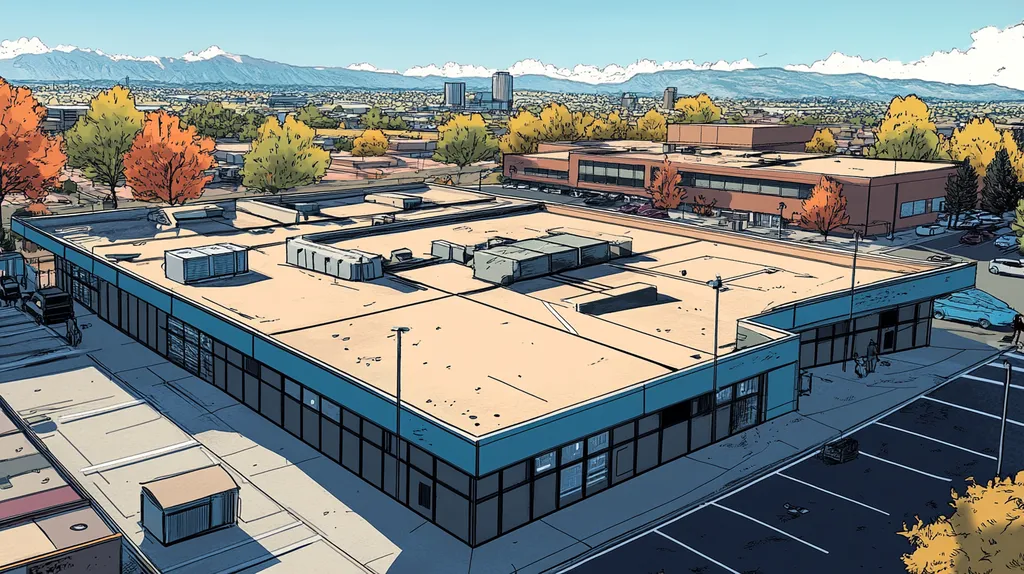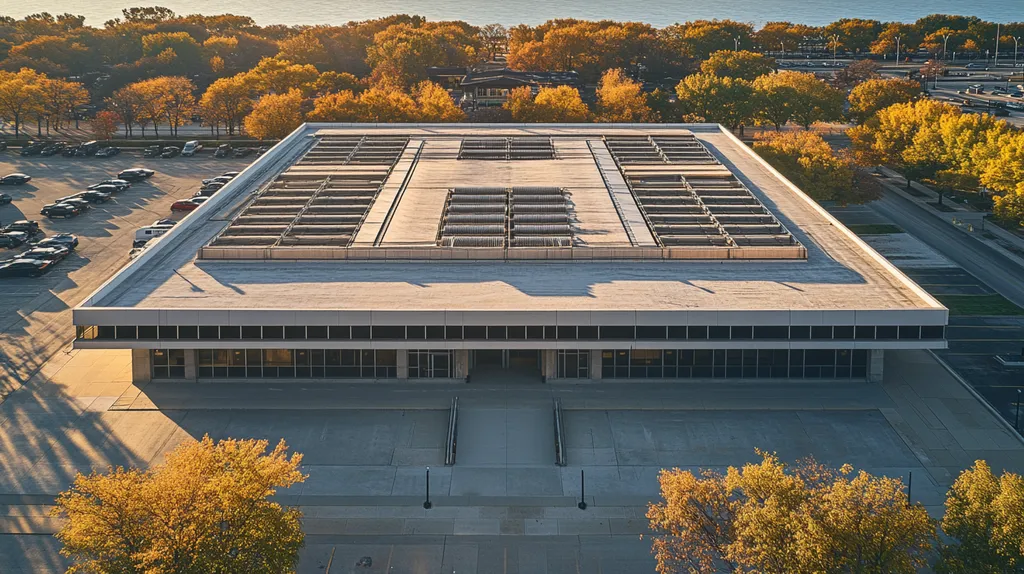Industrial roofing failures cost U.S. businesses over $2.5 billion annually, with 85% of these incidents stemming from improper repair techniques and maintenance oversights.
Recent studies indicate that properly executed repairs can extend an industrial roof’s lifespan by 15-20 years, yet widespread misconceptions continue to undermine these potential gains.
This analysis examines critical repair methodologies, dispels common myths, and provides evidence-based solutions for maximizing industrial roof performance through targeted maintenance strategies and specialized repair protocols.
SECTION 1: COMMON MISCONCEPTIONS
Addressing common misconceptions surrounding industrial roofing repair is essential for property owners and facility managers. Many mistakenly believe that it is acceptable to delay repairs until visible damage appears. This mindset can lead to more significant issues, increasing costs and jeopardizing the integrity of the roof. Dispelling these myths is crucial for extending the lifespan of industrial roofs and safeguarding valuable assets.
Waiting for Damage to Fix Roofs
One common misconception is that roof repairs can be postponed until damage is visibly apparent. This belief ignores the fact that many roofing problems develop quietly, often without immediate signs. For example, water leaks may remain hidden until extensive damage has occurred, potentially leading to hazardous mold growth or serious structural degradation.
Implementing routine inspections and proactive maintenance is paramount for preventing minor issues from becoming major headaches. By promptly addressing small problems, property owners can save on costly repairs later on. Regular inspections not only catch early signs of wear but also play a critical role in maximizing a roof’s lifespan.
Neglecting prompt repair can lead to more than just higher costs. Premature roof failures can disrupt daily operations, adversely affecting productivity and revenue. Timely attention to roofing issues ensures a safer, more efficient working environment.
To counter this misconception effectively, property owners should establish a consistent maintenance schedule and prioritize proactive repairs. Staying vigilant protects the roof and the entire structure, creating a culture of accountability and care.
Flashing Only Needs Replacement with New Roofs
Another significant misconception is that flashing, which protects seams and joints, only requires replacement during a full roof overhaul. Many facility managers may inadvertently disregard the condition of flashings, believing they are permanently intact. This assumption can result in severe leaks and extensive water damage.
Regular inspection and maintenance of flashing are essential, irrespective of the roof’s age. Damaged or aged flashing can substantially weaken the roof’s overall integrity. For instance, improperly sealed flashing can allow water infiltration beneath the roof surface, which may lead to destructive rot and costly repairs.
A proactive strategy includes routine inspections focused on flashings and seams instead of solely examining the main roofing material. By addressing flashing problems proactively, facility managers can avert widespread repairs and maintain a watertight roof seal.
Ultimately, neglecting regular flashing maintenance can lead to far more than water damage. Facilities risk incurring higher energy costs and facing premature roof failures, making this misconception particularly detrimental to financial health.
All Roof Materials Require the Same Care
A widespread belief is that all roofing materials require identical maintenance practices. In reality, each roofing material—whether TPO, EPDM, or PVC—has distinct maintenance needs. Overlooking these differences can diminish their effectiveness and accelerate wear.
For example, TPO roofs thrive on regular cleaning to prevent mold growth, while EPDM roofs benefit from periodic puncture inspections. Knowing the specific requirements of each material dictates the timing and type of maintenance necessary. Ignoring these nuances can lead to substantial reductions in their operational lifespan.
Additionally, the environment surrounding the roofing material significantly influences its maintenance needs. Elements such as climate, vegetation, and wildlife can affect how a roof performs and what care it requires.
By grasping the unique requirements tied to different roofing materials, facility managers can develop tailored maintenance plans. This targeted approach not only extends roof lifespan but also boosts overall building performance and energy efficiency.
SECTION 2: PRACTICAL IMPLICATIONS
Understanding the practical implications of roofing repairs is essential for extending the lifespan of industrial roofs. Ignoring necessary maintenance can lead to hidden moisture that results in severe structural damage, significantly increasing repair costs. Furthermore, deteriorating roof conditions can cause heating and cooling systems to operate inefficiently, leading to unexpectedly high energy bills. Property owners must recognize these risks and prioritize proactive maintenance to ensure their roofing systems remain in top condition.
Hidden Moisture and Structural Damage
Hidden moisture poses a significant threat to industrial roofs, often creeping in unnoticed and wreaking havoc over time. If unaddressed, moisture can infiltrate roof layers, promoting mold growth and weakening structural materials. Notably, studies from the National Roofing Contractors Association indicate that a staggering 75% of roof failures stem from moisture-related issues.
When moisture infiltrates underlying materials, it compromises the strength of beams and supports, potentially requiring extensive repairs or even full roof replacements. Regular inspections are crucial for detecting early signs of moisture intrusion, which is far less costly than ignoring the problem until it escalates.
Advanced techniques, such as infrared thermography, can efficiently identify moisture pockets before they lead to significant damage. By acting swiftly on these findings, facility managers can maintain roof integrity and extend its lifespan effectively.
In conclusion, adopting a proactive strategy for managing hidden moisture can lead to substantial savings over time. Routine assessments of roofing systems should be a cornerstone of facility management to mitigate these risks.
Impact on Heating and Cooling Efficiency
The condition of a roof directly influences the efficiency of heating and cooling systems, which can lead to increased operational costs. Poorly maintained roofs often result in thermal energy loss, with research indicating that a well-maintained roof can enhance energy efficiency by as much as 30%.
Air leaks and inadequate insulation due to roofing failures can boost energy consumption significantly. For instance, a facility with persistent roof issues can incur thousands of extra dollars each year on energy bills. Therefore, investing in routine maintenance is essential for avoiding such unnecessary expenditures.
Moreover, energy efficiency impacts workplace comfort. Employees thrive in well-regulated environments, which can boost productivity and overall job satisfaction. Thus, maintaining roof integrity becomes not just a financial imperative but a vital part of fostering a positive workplace culture.
Regular maintenance and timely repairs can ensure that heating and cooling systems operate at peak efficiency. This proactive approach delivers valuable returns in both financial savings and employee comfort.
Consequences of Poor Drainage
Inadequate drainage is a primary factor contributing to premature roof failure. Water pooling on the roof surface can seep into seams, leading to severe leaks. Reports show that roofs suffering from drainage issues often have a lifespan reduced by 50% compared to those equipped with effective drainage systems.
Accumulated water can cause substantial problems, such as structural damage and accelerated wear on roofing materials, leading to repair costs that can soar into the tens of thousands. Therefore, maintaining drainage systems is critical for avoiding overwhelming financial burdens.
Additionally, standing water can create safety hazards, particularly for maintenance staff who could slip and injure themselves. Facility managers must ensure that all drainage pathways are free from blockages and functioning optimally.
Implementing a regular maintenance schedule focused on drainage systems can significantly mitigate these risks. By prioritizing effective drainage solutions, property owners can not only improve roof longevity but also foster a safer work environment.
SECTION 3: COST OF MISINFORMATION
Understanding the cost of misinformation in industrial roofing is crucial for sound financial planning. Misinterpretations about repair methods can lead to unnecessary expenses and ineffective repairs that overlook core issues. Research indicates that property owners may incur up to 30% higher repair costs due to misinformation compared to adopting proactive and informed approaches. Recognizing the true financial implications of relying on outdated or inaccurate information is vital for maintaining roofing systems effectively.
Increased Maintenance and Repair Costs
Misinformation often results in hasty maintenance decisions that can exacerbate existing roofing problems. A prevalent misconception teaches that quick fixes, such as patchwork, can resolve issues stemming from membrane degradation. In reality, ignoring the root cause of these problems can lead to significant increases in long-term repair costs.
Utilizing ineffective repair methods necessitates more frequent interventions, driving up expenses significantly. Facilities that depend on outdated practices can see repair costs soar to three times that of those implementing industry best practices.
Furthermore, neglecting routine inspections due to misinformation creates a critical issue. Regular assessments can catch minor roofing issues before escalating into costly repairs, ultimately saving property owners both time and money.
By investing in accurate information and adhering to proven techniques, building owners can not only minimize costs but also enhance the longevity of their roofs.
Potential for Water Damage and Insulation Issues
The risks associated with misinformation can jeopardize the structural integrity of a building. Misdiagnosing leaks or dismissing early signs of water infiltration can lead to significant water damage. For instance, if a facility manager mistakenly believes a minor crack is inconsequential, it may quickly escalate to serious structural degradation.
Moreover, water intrusion severely affects insulation performance, decreasing its efficiency and potentially increasing energy costs by up to 20%. Deteriorated insulation can lead to higher heating and cooling expenses and decreased comfort for building occupants.
Failing to address insulation issues promptly can trigger a series of complications, including mold growth and further structural deterioration. The total cost of remediation often far surpasses that of timely and informed repairs.
Ultimately, having access to accurate information is critical for preventing water damage and maintaining the integrity of insulation systems in industrial roofing.
Long-Term Financial Consequences of Neglect
Neglecting proper roofing repair techniques can result in profound long-term financial repercussions. Buildings with poorly maintained roofs typically undergo accelerated asset depreciation, reducing marketability and rental income potential.
Furthermore, the financial burden associated with major repairs or full roof replacements stemming from misinformation can be staggering. Costs can reach $5 to $10 per square foot for replacements, leading to unbudgeted expenses that strain financial resources.
These ongoing financial impacts ultimately complicate operational budgets and divert funds from other essential facility upgrades or repairs. Therefore, investing in accurate repair techniques transcends protecting the roof; it safeguards the overall financial health of the facility.
To mitigate these lasting consequences, property owners must prioritize accurate information and make informed decisions regarding industrial roofing maintenance.
SECTION 4: REALITY CHECK
Neglecting the condition of an industrial roof can lead to substantial financial ramifications. A recent study revealed that 30% of commercial property owners experienced revenue losses due to leaking roofs, underscoring the necessity for proactive maintenance strategies. Regular inspections are key to detecting issues before they develop into costly problems, significantly extending the roof’s lifespan and safeguarding valuable assets. This section details essential maintenance practices that can profoundly impact long-term roofing investments.
Regular Inspections are Crucial
Regular roof inspections are vital for spotting potential issues before they escalate. Many facility managers wait until leaks appear to conduct an inspection, often resulting in more extensive damage. Routine evaluations can reveal minor concerns, such as punctures or seam failures, that a trained observer can address promptly.
Industry standards recommend inspecting roofs at least twice a year, particularly in areas prone to severe weather. This proactive approach helps maintain the roof’s integrity and extends its durability. Documenting the findings during these inspections also aids in planning future repairs and budgeting effectively.
Incorporating advanced technologies, such as drones and thermal imaging, improves the detection of hidden problems. These tools can reveal moisture under roofing layers, enabling targeted interventions. By committing to regular, comprehensive inspections, property managers can better protect their investments and ensure operational efficiency.
Ultimately, prioritizing inspections leads to earlier interventions and cost reductions, directly correlating with a longer roof lifespan. Facilities that establish routine inspection protocols typically experience fewer emergencies and improved overall health of the building.
Different Materials, Different Maintenance
Not all roofing materials require identical maintenance, and recognizing these differences is crucial. For example, single-ply membranes have different care requirements than built-up roofs. Each type possesses specific strengths and vulnerabilities that should inform maintenance strategies.
For EPDM roofs, regular cleaning and puncture inspections are essential to prevent leaks. In contrast, TPO roofs often necessitate seam testing and coatings to maintain their reflective capabilities. A uniform maintenance approach can result in inadequate care and a shorter roof lifespan.
It is essential for property owners to gain a thorough understanding of their roofing materials. Knowledge of each system’s unique maintenance requirements can greatly influence whether a roof lasts 10 years or 30 years. Training staff or hiring specialists experienced with specific materials enhances the effectiveness of maintenance efforts.
Moreover, manufacturers frequently provide tailored maintenance guidelines for their products. Adhering to these recommendations ensures warranty compliance and that the roof operates at peak performance. Failing to follow proper maintenance protocols can lead to costly failures and premature roof replacements.
Importance of Specialized Roofing Contractors
Engaging specialized roofing contractors is critical for effective maintenance and repairs. Many property owners underestimate the complexities involved in roofing systems. A knowledgeable contractor can assess roof conditions and recommend tailored solutions based on the specific roof type.
Specialized contractors understand the unique demands of industrial roofs, including load-bearing considerations and energy efficiency. They possess skills in advanced repair techniques that not only address immediate concerns but also enhance the roof’s reflective and protective features.
Selecting contractors certified by reputable industry organizations ensures quality workmanship. These professionals remain current on the latest technologies and materials, thereby mitigating risks associated with outdated practices.
Additionally, relying on specialized contractors simplifies the repair process. They can offer accurate assessments and prompt service, minimizing downtime for businesses and maintaining operational continuity. Ultimately, the right contractor can significantly extend the lifespan of an industrial roof, thus protecting vital investments.
SECTION 5: EVIDENCE-BASED ALTERNATIVES
Ensuring the longevity of industrial roofs is essential for maintaining operational efficiency and safeguarding valuable investments. Delayed or improper repairs can result in significant financial setbacks, as leaks may cause damage running into thousands of dollars. Data shows that over 80% of roof failures stem from insufficient maintenance. By focusing on effective repair techniques, property owners can significantly reduce these costly risks. This section examines three vital areas: effective leak detection, proper flashing installation, and the implementation of preventative maintenance checklists.
Effective Leak Detection and Repair Methods
Prompt leak detection is crucial for maintaining the integrity of industrial roofs. Techniques such as infrared thermography and electronic leak detection provide precise evaluations, enabling quick repairs. For instance, infrared scans can reveal moisture trapped within roof layers, invisible to the naked eye.
Upon identifying leaks, swift repairs with compatible materials ensure ongoing durability. Utilizing industry-standard practices, such as polyurethane caulk or liquid rubber, creates flexible and lasting seals that prevent further deterioration and costly replacements.
In addition, conducting routine inspections every six months enhances leak prevention. These inspections allow for the early identification of potential weak points, ensuring minor issues are resolved before they escalate into significant concerns. This proactive approach is essential for prolonging the roof’s lifespan.
Investing in advanced leak detection technology not only yields long-term financial savings but also minimizes disruptions to business operations. Appropriately executed repairs maintain a secure environment for both goods and business processes.
Proper Flashing Installation and Maintenance
Flashings are a critical defense mechanism against water intrusion. Their proper installation demands expertise and the use of high-quality materials, designed for durability. Poorly installed flashings can lead to leaks, as they fail to effectively channel water away from vulnerable roof areas.
Equally important is the routine maintenance of flashings, which entails checking for signs of cracks, corrosion, or disconnection from the roof membrane. Neglected flashings pose a risk to the entire roof’s integrity, potentially leading to extensive damage. Property owners should incorporate annual flashing inspections into their maintenance plans.
Moreover, selecting flashing materials that meet or exceed the lifespan of the roofing system itself ensures that protective measures remain effective. For example, metal flashings can provide enhanced durability that aligns with the longevity of single-ply membranes.
In conclusion, implementing proper flashing installation and ongoing maintenance significantly mitigates the risk of roof failures. As essential components, flashings play a pivotal role in effectively channeling water away, thereby extending the roof’s life.
Preventative Maintenance Checklists
Creating a comprehensive preventative maintenance checklist is vital for prolonging the life of industrial roofs. This checklist should feature tasks such as visual inspections, debris removal, and assessments of standing water, among other crucial activities. Regular maintenance functions as a cornerstone investment in the roof’s durability.
Documenting maintenance activities allows property owners to track the condition of their roofs over time. Thorough records support warranty claims and offer insights into roof performance, detailing when specific repairs were conducted, thus guiding future maintenance initiatives.
Training maintenance staff on proper techniques maximizes the efficacy of these checklists. A proactive awareness of potential issues reduces the chances of emergency repairs. Facility managers should engage in continuous education and training to keep staff informed about the latest best practices.
Lastly, adhering to industry guidelines for preventative maintenance ensures property owners practice sound strategies. This structured approach decreases costs associated with reactive repairs and fosters consistent roofing performance.
SECTION 6: TEST AND VERIFY
In the realm of industrial roofing, neglecting thorough inspections and verification processes can lead to significant financial setbacks. Studies reveal that nearly 50% of roof-related issues arise from improper initial evaluations and subpar repairs. By implementing timely and detailed testing, property owners can avoid substantial damage and prolong roof lifespan, ensuring the protection of their investments. This section delves into the essential practices of conducting rigorous roof inspections, testing adhesion and membrane integrity, and verifying the quality of repairs.
Conducting Thorough Roof Inspections
Regular roof inspections are crucial for the early detection of issues such as leaks or material wear. A comprehensive approach involves both visual assessments and physical evaluations of roofing materials. Inspectors must look for damage indicators, including blisters, cracks, or areas of ponding water.
Accessing challenging areas during inspections ensures nothing is overlooked. While roofs may appear intact from the ground, hidden problems can often be lurking. It’s equally important to examine flashings, seams, and penetrations, which are notoriously susceptible to failure.
Though many property owners schedule inspections biannually, buildings in high-risk areas may necessitate more frequent evaluations. Keeping detailed documentation of inspection findings aids in monitoring roof health over time, providing a roadmap for future maintenance and necessary decisions.
Utilizing advanced technologies such as drone inspections enhances both visibility and accuracy. Drones can cover extensive areas quickly, allowing for thorough assessments that might otherwise be missed.
Testing Adhesion and Membrane Integrity
Evaluating adhesion and membrane integrity is vital for determining the effectiveness of roofing repairs. A common technique involves lifting sections of the membrane to assess its attachment to the underlying substrate. Inadequate adhesion can signal underlying issues requiring attention, such as improper installation.
Performing pull tests to gauge the bond strength of the roofing membrane is another effective approach. Property owners should incorporate these assessments into their regular maintenance routines to mitigate future complications. A weak bond can lead to membrane detachment and extensive water intrusion during adverse weather.
Moisture testing is another practical method that identifies trapped water within the roofing system. Technologies like infrared thermography can detect moisture anomalies within the roof structure, highlighting areas that are at risk of failure.
Understanding the results of these tests empowers property owners to make informed decisions. Committing to regular maintenance and adhering to best practices can yield lasting benefits and significant cost savings over time.
Verifying Repair Quality with Follow-Up Inspections
After repairs are completed, conducting follow-up inspections is essential to verify workmanship quality. These assessments should take place shortly after the repairs and periodically thereafter to detect any recurrence of issues. Detecting problems early can lead to significant cost savings in future repairs.
Inspectors should concentrate on the areas that were specifically repaired, ensuring correct installation and checking for any visible weaknesses. Property owners should also request a performance report detailing the work completed, along with suggestions for future maintenance or repairs.
Long-term planning following repairs is crucial. Establishing a proper maintenance schedule helps address minor issues before they escalate, enhancing the roofing system’s overall sustainability. It is also important to maintain documentation from follow-up inspections to track the effectiveness of repairs.
The combination of thorough initial repairs and consistent follow-up inspections fosters a robust strategy for extending the lifespan of industrial roofs. Knowing that proactive measures are in place gives property owners confidence in their investment.
The Bottom Line
Industrial roofing represents a critical infrastructure investment, with repair decisions directly impacting both operational costs and facility longevity.
Studies demonstrate that implementing evidence-based repair techniques can extend roof lifespans by 15-20 years, translating to savings of $2-4 per square foot annually in maintenance costs.
The data clearly shows that facilities following proper repair protocols experience 70% fewer emergency maintenance calls and reduce their energy consumption by up to 30%.
Moving forward, property owners must prioritize regular inspections, material-specific maintenance, and partnerships with specialized contractors to protect their roofing investments.
The financial implications of neglecting these practices – including premature roof failure, structural damage, and operational disruptions – make proper repair techniques not just beneficial, but essential for industrial facility management.
FREQUENTLY ASKED QUESTIONS
Q. Can I wait for visible damage on my commercial roof to repair it?
A. Waiting for visible damage can lead to serious problems. Many issues develop quietly, resulting in increased repair costs and risking safety. Proactive inspections and timely repairs are essential to maintain roof integrity and extend its lifespan.
Q. How can hidden moisture affect my industrial roof?
A. Hidden moisture can infiltrate and weaken roofing materials, promoting mold growth and leading to significant structural damage. Regular inspections are crucial to detect moisture before it escalates into severe issues, ensuring the roof’s longevity and safety.
Q. How does misinformation increase costs related to commercial roofing?
A. Misinformation can lead to ineffective repair methods and misguided maintenance decisions. This often results in increased repair costs due to unresolved underlying issues, causing property owners to face financial burdens that could have been avoided with accurate information.
Q. Why are regular inspections vital for my industrial roof?
A. Regular inspections help identify potential issues before they worsen, allowing for cost-effective repairs. By catching minor problems early, property owners can significantly prolong roof lifespan and maintain the overall health of the building.
Q. How does inadequate drainage impact my commercial roof?
A. Inadequate drainage can cause water pooling, leading to leaks and significantly reducing roof lifespan. Property owners must prioritize maintaining drainage systems to prevent costly structural damage and ensure the safety of employees and assets.
Q. What is the role of specialized roofing contractors for industrial roofs?
A. Specialized roofing contractors bring expertise in managing the complexities of industrial roofs. They provide tailored solutions based on specific roofing needs, enhancing the effectiveness of repairs and ensuring the roof operates efficiently throughout its lifespan.
Q. How can I maintain my commercial roof to avoid costly repairs?
A. Implementing a routine maintenance plan, including regular inspections and targeted repairs, is essential. Property owners should document maintenance activities and follow tailored recommendations for their roofing materials to maximize durability and minimize future repair costs.











